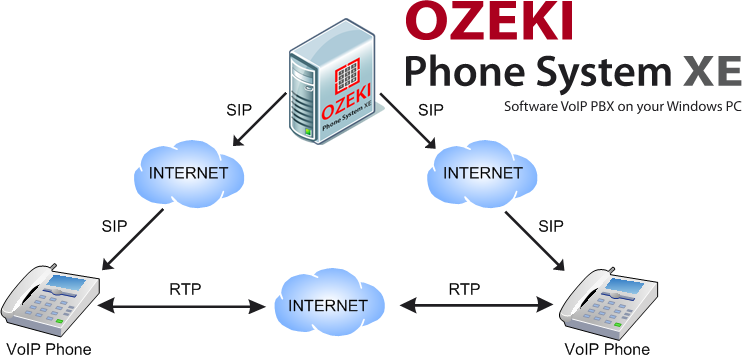What is RTP (Real-time Transport Protocol)?
This page will be about RTP (Real-time Transport Protocol) that transfers data. In the first few paragraphs, get informed about the definition of RTP, how it is built up, what kind of components it has. Right after that check out a little overview of he protocol and its profile.
RTP is defined as a standard packet format that is responsible for transmitting video and audio data over the Internet (Figure 1). As you can see on Figure 1, there are two VoIP phones that are connected to the Ozeki Phone System and they communicate with each other while RTP transmits data between them.

An RTP packet builds up like this: If 3 packets are transported in RTP, they are sent to RTP payload segment. Since an RTP packet is an UDP packet it consists of an UDP header, an IP header and also an RTP header as it is transported via RTP.
RTP provides data delivery from one point to another with real-time features. With the help of RTP interactive audio and video data can be sent over multicast(transmits data to more destination computers at the same time) or unicast transmission (transmits data to only one network).
Network and transfer protocols apply RTP. Its task is to deliver real-time media data. Mainly communication and entertainment systems apply RTP when they use telephoning, video conferencing and push-to-talk functionalities.
That is the main reason RTP is an essential element of VoIP technology.
Protocol Components
Overview
The Real-time Transport Protocol was designed to transport data to the end points and it has real-time characteristics. The RTP has different features like jitter compensation, detection of out of sequence arrival in data. It supports multimedia streaming that can tolerate packet loss.
A session is established for data transmission. It consists of an IP address, RTP and RTCP ports.
Profile
The Real-time Transfer Protocol supports diferent kinds of formats, like MPEG, MJPEG but additional formats can be added to it. The Profile defines those codecs that convert the payload data and their way to payload format codes.
Ozeki Phone System uses RTP protocol to deliver multimedia data over the Internet. You can download Ozeki Phone System from our site.
For further infomation about RTP related topics read our pages:
If you became interested in this topic, please watch our video:
What is RTP? (Video tutorial)
